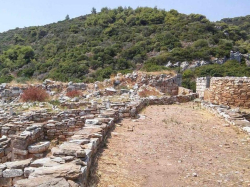Archaeological Site of Ramnounda

Archaeological Site of Ramnounda
As a city, it developed in the 5th and 4th Century B.C. and had always been considered a very important fortification. Up to this day, excavations in Ramnounda have not revealed any monuments from the 5th Century and on wards. This fact itself states that the worship of Nemesis took place at that period and not earlier.
The older remains of any sanctuary, dedicated to Nemesis is a small one that is called Themis Temple. The most important in the area is the temple of Nemesis although only a few parts and columns have been saved.
The temple itself had 6 rows of columns, each of them consisted of 12 columns. At the back of the temple, there was a niche with a lobby and a room with representations. The temple was built in the 5th Century B.C.. It was made of white marble and on its basis of brown marble.
The main temple of Nemesis had in its interior a statue of Nemesis goddess made by Agorakritos, Phidias' student. It is said to be the architect who also created the Temple of Hephaestus, in Thissio the Temple of Ares in Ancient Agora in Athens as well as the Temple of Poseidon in Sounio.
The roof of the temple of Nemesis is decorated with marble panels painted with gold stars on a blue background. It is semi-similar to the Parthenon's and the drainpipes have the shape of lion heads.
The pediments don't have any sculptured decoration and on the east side, they do have sculptured metopes. During the Roman period, this temple was dedicated to the wife of August, Livia - who died in 29 A.D.
In the south of Nemesis temple, there is a small building that looks like a temple. It is the temple of Themis, dated in the 5th Century B.C. but it is said that both goddesses were worshiped in both temples. This temple is full of dedications and makes a complex building system.
One of the most important dedications is the statue of Themis, which is in the National Archaeological Museum. In the lobby of this temple, 2 marble thrones were found dedicated to Nemesis and to Themis.
In Ramnounda, one can find a temple that is the healing sanctuary of Aristomachos, which along with the most popular Amphiraos were the 2 most worshiped deity's in Ramnounda. The sanctuary of Aristomachos was an open space temple. Last but not least there are many cemeteries that are found in this area, decorated with sepulchral relief.







